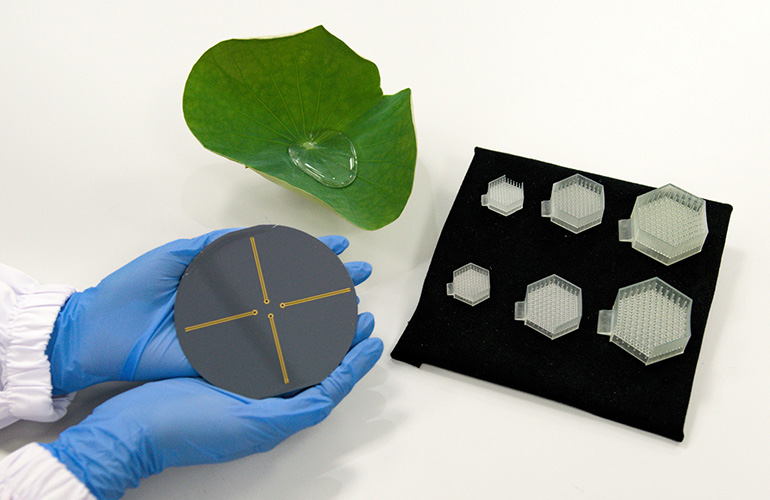|
Listen to this article  |

eAir sensors, the gold strips on the circular panel, mimic the lotus leaf effect, a phenomenon where water droplets roll of the leaf’s surface. | Source: NUS
Researchers at the National University of Singapore (NUS) have developed eAir, an aero-elastic pressure sensor inspired by lotus leaf’s water-repelling structures. eAir sensors offer increased precision and reliability for medical applications over traditional sensors.
Conventional pressure sensors often struggle with accuracy and consistency. They can return varying results when the same pressure is applied repeatedly or overlook subtle changes in pressure. Additionally, they’re typically made from stiff and mechanically inflexible materials.
The NUS research team wanted to address these drawbacks in pressure sensing and drew inspiration from a natural phenomenon called the lotus leaf effect, where water droplets easily roll off the surface of lotus leaves. This happens because of the lotus leaves’ minuscule, water-repelling structures.
The team mimicked the lotus leaf effect by reimagining the water-repelling capabilities of the lotus leaf as a pressure-sensing tool. The eAir sensor has an air spring design, in which the sensor houses a trapped layer of air. This air forms an air-liquid interface upon contact with the sensor’s liquid.
Aso, as external pressure increases, the air layer compresses. A surface treatment enables frictionless movement of the interface within the sensor, which triggers a change in electrical signals that accurately reflect the exerted pressure.
“The sensor, akin to a miniature ‘capacity meter’, can detect minute pressure changes — mirroring the sensitivity of a lotus leaf to the extremely light touch of a water droplet,” Benjamin Tee, lead researcher and an associate professor from the NUS College of Design and Engineering and NUS Institute for Health Innovation & Technology, said.
eAir devices can be made a few millimeters in size, which is comparable to the size of existing pressure sensors. This technology could potentially be used to perform laparoscopic surgeries by enabling tactile feedback for surgeons, which results in more precise manipulation of patient tissues.
“When surgeons perform minimally-invasive surgery such as laparoscopic or robotic surgery, we can control the jaws of the graspers, but we are unable to feel what the end-effectors are grasping. Hence, surgeons have to rely on our sense of sight and years of experience to make a judgment call about critical information that our sense of touch could otherwise provide,” Dr. Kaan Hung Leng, a consultant for the Department of General Surgery at the National University Hospital, Ng Teng Fong General Hospital and NUS Yong Loo Lin School of Medicine, said.
This device could also be used to improve patient experiences when it comes to managing brain-related conditions, ranging from severe headaches to potential brain damage. For example, it could offer a less invasive means of monitoring intracranial pressure (ICP), an important health metric for people with neurological conditions.
The team’s findings were recently published in the journal Nature Materials. The NUS team is laying the groundwork for collaborations with key players in the medical field and has also filed a patent for the eAir sensor technology in Singapore.
Credit: Source link


Comments are closed.